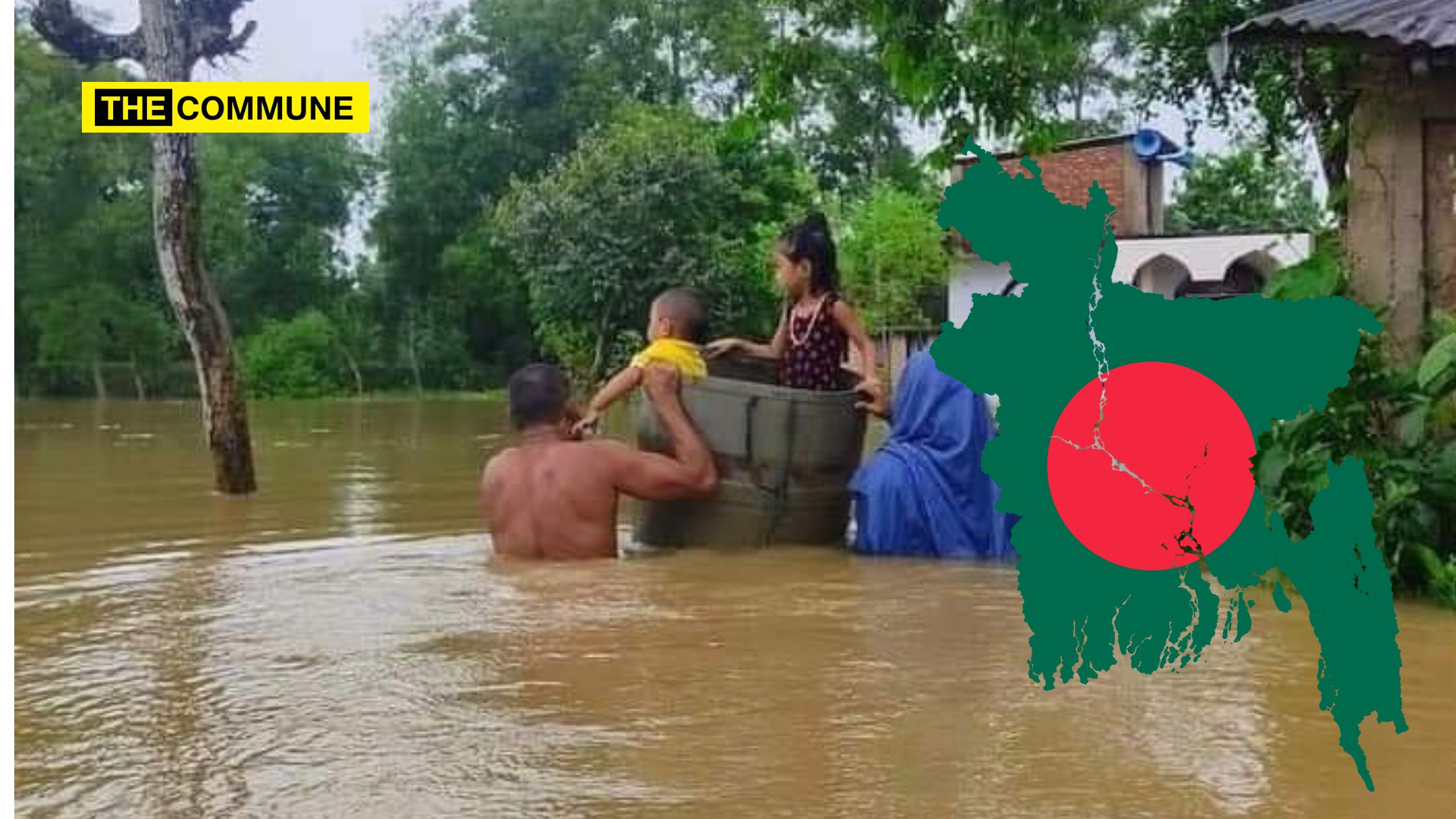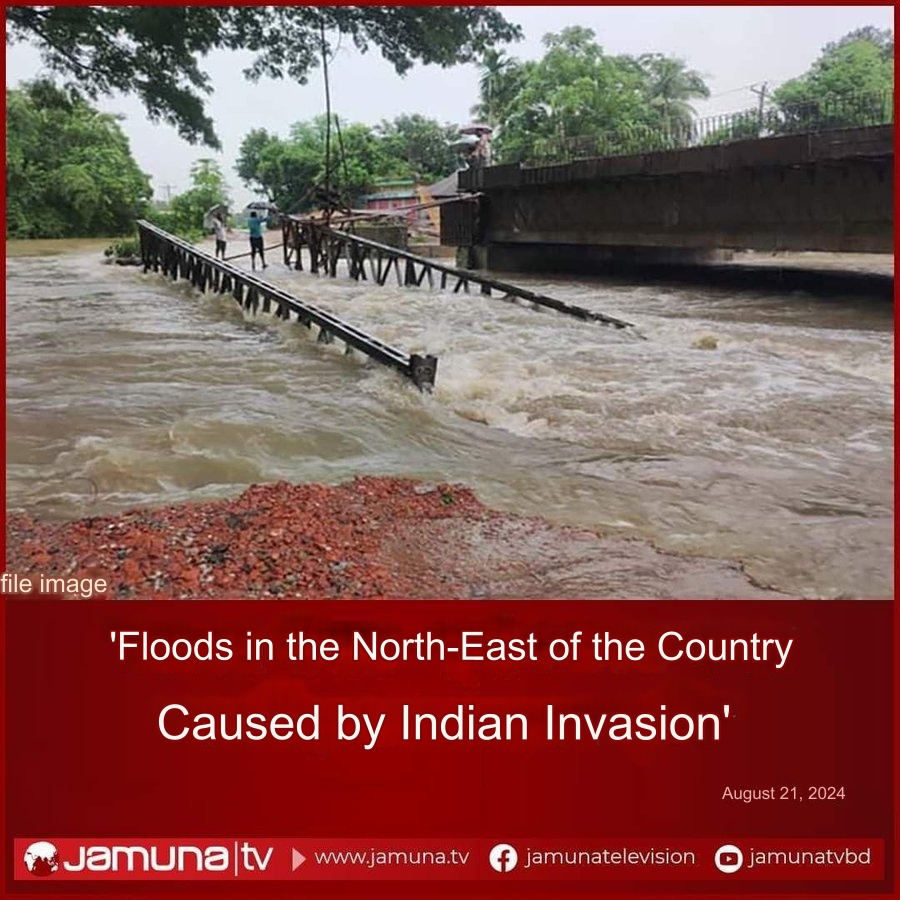
Even as torrential rains engulf eastern Bangladesh, leaving millions displaced and infrastructure devastated, a bitter dispute with India has erupted over the cause of the flooding. While the Bangladeshi government blames India for releasing water from dams upstream, India vehemently denies the allegations, pointing to the unprecedented rainfall as the primary culprit.
Already reeling from a wave of violent protests that have left a trail of destruction and suffering, Bangladesh now faces an even more formidable adversary: the relentless onslaught of devastating floods. The flood-stricken region has been grappling with rising water levels for weeks, submerging entire villages and cutting off essential services.
The government has launched a massive rescue operation, deploying the army, navy, and air force to reach stranded individuals. However, the situation remains dire, with many fearing for their lives and livelihoods.
Flooding In Bangladesh
Severe flooding has struck eight districts in eastern Bangladesh, submerging hundreds of villages and leaving millions stranded. The affected districts include Sunamganj, Moulvibazar, Habiganj, Feni, Chittagong, Noakhali, Comilla, and Khagrachhari. Described by some as the worst flood in living memory, the disaster has caused significant damage to infrastructure and agriculture.
Meteorologist Mostofa Kamal Palash identified three primary factors contributing to the floods: a persistent monsoon low-pressure system, a robust Madden-Julian Oscillation, and the jet stream’s current position over Central Asia. The Bangladesh Meteorological Department (BMD) attributed the flooding to a low-pressure system formed in the southern part of the country.
Water levels have risen by up to three meters in some areas within 24 hours. Rivers like the Muhuri, Juri, and Khowai have reached record-high levels. The Flood Forecasting and Warning Centre reported at least seven rivers flowing above their danger marks at nine points across the affected regions.
The flooding has submerged agricultural lands, destroyed fish and poultry farms, damaged flood protection dams and roads, inundated parts of the Dhaka-Chattogram highway, and disrupted emergency health services in some areas.
Bangladesh Rescue Mission
Authorities have mobilized the army, navy, coast guard, and fire service for rescue missions. Helicopters are being used to airlift stranded individuals. Flood shelters have been opened in educational institutions and government offices. The Bangladesh Red Crescent Society has set up control rooms and formed rescue teams.
In Feni, 200 villages are flooded, with water levels reaching up to 12 feet in some areas. Moulvibazar’s Kamalganj upazila has seen 25 villages inundated and about 1,000 hectares of paddy fields submerged. Cumilla is experiencing rapid swelling of the Gomati River. In Brahmanbaria, 30 villages in Akhaura are inundated. Noakhali estimates that 90% of the district is underwater, affecting about 20 lakh people.
Experts suggest the flood situation may improve quickly due to the nature of flash floods. However, concerns remain about long-term impacts on affected communities.
Bangladeshi Media Blames India For Floods
Several media houses, aided by anarchist elements, attribute the flooding to the opening of gates at India’s Dambur hydroelectric project in Tripura. They claim this action has contributed to flooding in bordering Bangladesh districts. Water released from the Dumboor hydroelectric dam in India’s Tripura state has allegedly impacted the Gumati River basin in Bangladesh. Additionally, recent damage to a hydropower dam on the Teesta River in Sikkim, India, has raised concerns about potential flooding impacts downstream in Bangladesh. Here are some media ‘reports’ blaming India for the inundation.
Popular Bangladeshi channel Jamuna TV blamed ‘Indian aggression’ for the flooding in the North-eastern region of Bangladesh.

Another report claimed that India opened the dam in Tripura which led the water to flood Bangladesh.

Derek Grossman, a ‘senior defence analyst’ who has been repeatedly nitpicking every move India makes and setting a narrative in the global media, also endorsed the Bangladeshi reportage of India wantonly opening the dam to cause flooding in the country.
If India indeed opened the Dambur hydroelectric project in Tripura state without notifying Bangladesh, and if this was done in political retaliation against the new govt, then New Delhi must be held to account. To be fair, heavy rains preceded this event.https://t.co/jAlt9FTUMM
— Derek J. Grossman (@DerekJGrossman) August 21, 2024
MEA Denies Claims
The Ministry of External Affairs (MEA) of India has refuted allegations that the opening of the Dumbur dam in Tripura caused the current flood situation in Bangladesh’s bordering districts. The MEA labelled these claims as “factually incorrect” and emphasized the need for cooperative efforts to manage shared water resources.
According to the MEA, however, the flooding is primarily due to “some of the heaviest rains of the year” in the catchment areas of the Gumti River, which spans both India and Bangladesh.
“We have seen concerns being expressed in Bangladesh that the current situation of flood in districts on the eastern borders of Bangladesh has been caused by opening of the Dumbur dam upstream of the Gumti River in Tripura. This is factually not correct,” the MEA stated in a release.
The MEA further clarified that Bangladesh’s floods are the result of natural water flow from extensive catchment areas and reiterated that floods on shared rivers are a common issue affecting both nations. The ministry stressed the importance of “close mutual cooperation” in addressing and resolving such challenges.
“Floods on the common rivers between India and Bangladesh are a shared problem inflicting sufferings to people on both sides, and requires close mutual cooperation towards resolving them,” the MEA added.
Flood situation in Bangladesh not due to release of waters from Indian dam on Gumti River, Tripura:https://t.co/8hcnRkoBF1 pic.twitter.com/p5zY0LII7D
— Randhir Jaiswal (@MEAIndia) August 22, 2024
The MEA underscored that river water cooperation is crucial to bilateral relations between India and Bangladesh. These two countries share 54 rivers. The ministry reaffirmed its commitment to resolving water resource issues through ongoing consultations and technical discussions.
Tripura Power Minister Comments
In response to these allegations, Tripura Power Minister Ratan Lal Nath asserted that Dumbur dam gates were closed. He explained, “No gate has been opened for Gomti Hydro Electric Project. The reservoir’s storage capacity is up to 94 meters. Once the water crosses this level, it will automatically exit through the gate. Again, the gate will automatically close when the reservoir’s water level falls below 94 meters.”
গোমতি হাইড্রো ইলেকট্রিক প্রজেক্ট এর কোন গেইট খুলে দেওয়া হয়নি। রিজার্ভারের ধারণ ক্ষমতা ৯৪ মিটার পর্যন্ত। জল এই স্তর অতিক্রম করলেই অটোমেটিক্যালি গেট দিয়ে বেরিয়ে যাবে। আবার রিজার্ভারের জল স্তর ৯৪ মিটারের নিচে নেমে গেলে অটোমেটিক্যালি গেইট বন্ধ হয়ে যাবে। pic.twitter.com/qOVLtOoksR
— Ratan Lal Nath (@RatanLalNath1) August 21, 2024
(This article is based on a thread by Sensei Kraken on X)
Subscribe to our Telegram, WhatsApp, and Instagram channels and get the best stories of the day delivered to you personally.




